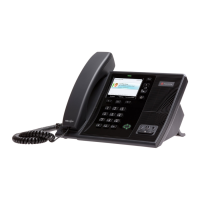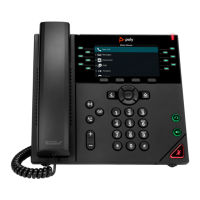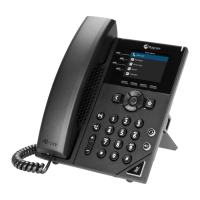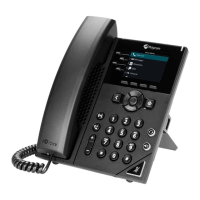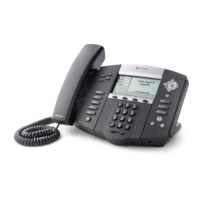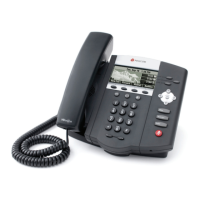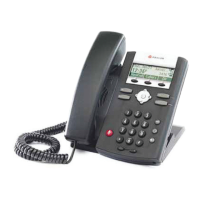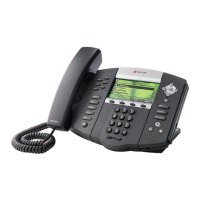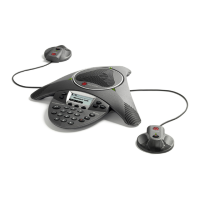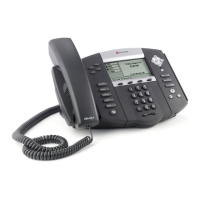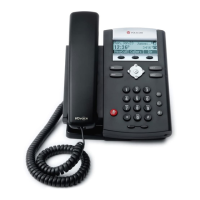
Do you have a question about the Polycom Business VoiceEdge and is the answer not in the manual?
| Category | IP Phone |
|---|---|
| Lines | Up to 12 lines |
| Display | Backlit LCD |
| Network Interfaces | 10/100/1000 Ethernet |
| Supported Protocols | SIP |
| Power Supply | IEEE 802.3af Power over Ethernet (PoE) Class 2 |
| Audio Codecs | G.711, G.722, G.729 |
Highlights key features like Call Forward Not Reachable, Voicemail, Voicemail to Email, and HD Voice calling.
Explains how to access features via Telephony Toolbar, Online Web portal, and feature access codes.
Details the buttons and functions of the Polycom 335 and 560 series IP phones.
Explains navigation arrows for call logs and the role of soft keys on Polycom phones.
Covers methods for placing calls using number pad, call logs, and setting up voicemail.
Guides on listening to voicemail, performing call transfers, and initiating 3-way calls.
Steps for downloading, installing, and activating the Telephony Toolbar for feature access.
How to dial using the toolbar, Outlook, and features like Speed Dial and Be Anywhere.
Details on using Be Anywhere for mobile calls and moving calls between devices.
Overview of the mobile app's capabilities for managing calls and voicemail.
Instructions for first-time voicemail activation, personalized greetings, and accessing messages.
Details on playing, saving, deleting messages, and managing greetings from the voicemail menu.
How to use the voicemail box for call forwarding and leaving messages for group users.
Logging into the online portal, setting ring counts, and managing voicemail indicators.
Configuring voicemail forwarding to email and setting up email notifications for new messages.
Instructions for uploading WAV files for no-answer and busy greetings.
How to create and manage distribution lists for sending bulk voicemail messages.
Details on performing basic, consultative, and direct-to-voicemail call transfers.
How to place calls on hold, resume them, and return the last incoming call.
Managing incoming calls with Call Waiting and viewing Caller ID information.
Using Do Not Disturb and understanding extension dialing for intra-office communication.
Setting up Selective Call Acceptance and Rejection to manage incoming calls.
How to pick up calls from other extensions and join ongoing calls.
Information on downloading, configuring, and system requirements for the Telephony Toolbar.
Overview of the toolbar interface, including services, call controls, and contact dialing.
Details on Anonymous Call Rejection, Call Forwarding options, and Do Not Disturb.
Information on delivering calling line ID for external and internal callers.
Setting up Be Anywhere, including locations, alerts, and advanced options.
Instructions to activate or deactivate the Be Anywhere feature on your phone.
How to move active calls between your mobile and desk phone or soft client.
Steps to enable and configure the Remote Office feature for remote work.
How to make outbound calls and receive inbound calls when Remote Office is active.
Using Outlook contacts to initiate calls via the Telephony Toolbar.
Explanation of how alternate numbers work for receiving calls and outbound dialing.
How to activate and deactivate Call Forwarding Always from phone and online.
Instructions to activate and deactivate Call Forwarding Busy via phone and online.
Instructions to activate and deactivate Call Forwarding No Answer via phone and online.
How to forward calls based on specific criteria like caller number or time.
How to configure sequential ringing across multiple numbers for missed calls.
How to configure Call Notify to send email alerts for specific incoming calls.
Steps to turn the Call Notify feature on or off.
How to enable your phone as a host for other users to associate their profiles.
Steps for a user to associate their service profile with a Hoteling Host.
Designating a phone as a Hoteling Host or deactivating this role.
Overview of controls for Hoteling Guest users via the voice portal.
How to configure Priority Alert for distinct ring tones based on call criteria.
Steps to turn the Priority Alert feature on or off.
Options to control visibility in directories and phone status privacy settings.
How to select specific users who can monitor your phone status.
Lists the hardware and software specifications needed for Bria Softphone.
Details acceptable microphone and speaker configurations for Bria Softphone.
Guide to downloading, installing, and logging into the Bria Softphone application.
Introduction to the Bria Softphone's main interface elements and functions.
Methods for placing, answering, ending, and holding calls within Bria Softphone.
Details on call transfers (consultative, blind), volume control, mute, and speakerphone.
How to conduct three-way calls and merge active calls within Bria Softphone.
How to access voicemail messages directly from the Bria Softphone interface.
Steps for initial launch, desktop icon creation, and accessing the console login.
Overview of the console's work areas and how to manage calls using its workflow.
Lists the hardware and software specifications required for the Reception Console.
Configuration for Music On Hold and the Call Park feature for holding calls.
How to park calls and retrieve them from different locations using feature codes.
Using Call Pickup to answer calls within a group and Busy Lamp Field for monitoring.
Configuration of shared line appearance and multiple call arrangements.
How to use Automatic Callback for busy lines and Push to Talk for instant communication.
Overview of the Auto Attendant feature for routing incoming calls efficiently.
Information required for configuring Auto Attendants and Hunt Groups.
Details on different Hunt Group ringing patterns and setup requirements.
Explanation of how directory number hunting functions within groups.
How to set up automatic call forwarding during service outages or unavailability.
Overview of other continuity features like Voicemail to Email and Call Notify.
How to block your number for individual calls or all calls on a line.
How to reject calls where the caller's ID is blocked or anonymous.
How to access and manage your monthly bills and call records online.
Steps to add payment accounts and opt-in for automatic monthly payments.
Overview of various reports available for call details and billing summaries.
Information on international calling options and blocking specific number types.
Information on contacting support and using directory assistance services.
Details on Diversion Inhibitor and enhanced directory assistance features.
Information on IP phones and procedures for 911 emergency calls.
How Toll Free Service can help expand business by enabling toll-free customer calls.
How to use last number redial and information on feature lists.
Instructions for domestic and international dialing, and contacting operator services.
Guide on how to find and use feature access codes via the online portal.
A detailed list of feature access codes for activation and deactivation.
Index entry for 3-Way Calling, referencing page 8.
Index entry for Alternate Numbers, referencing page 29.
Index entry for Anonymous Call Rejection, referencing page 54.
Index entry for Auto Attendant, referencing pages 48-49.
Index entry for Automatic Callback, referencing page 48.
Index entry for Basic Call Logs, referencing page 48.
Index entry for Be Anywhere, referencing pages 11-12, 25-27.
Index entry for Block Calls, referencing page 57.
Index entry for Bria Softphone, referencing pages 37-43.
Index entry for Business Level Support, referencing page 58.
Index entry for Busy Lamp Field, referencing page 47.
Index entry for Call Detail Records, referencing pages 56-57.
Index entry for Call Forwarding Always, referencing page 29.
Index entry for Call Forwarding Busy, referencing page 30.
Index entry for Call Forwarding No Answer, referencing pages 30-31.
Index entry for Call Forwarding Not Reachable, referencing page 52.
Index entry for Call Forwarding Selective, referencing page 31.
Index entry for Call Hold, referencing page 19.
Index entry for Call Notify, referencing page 32.
Index entry for Call Park, referencing page 46.
Index entry for Call Pickup, referencing page 47.
Index entry for Call Return, referencing page 20.
Index entry for Call Park and Retrieve, referencing page 46.
Index entry for Call Transfer, referencing pages 8, 19.
Index entry for Call Transfer with Consultation, referencing page 19.
Index entry for Call Transfer Direct to Voicemail, referencing page 19.
Index entry for Call Waiting, referencing page 20.
Index entry for Caller ID with Call Waiting, referencing page 20.
Index entry for Caller ID Blocking per Call, referencing page 54.
Index entry for Caller ID Blocking per Line, referencing page 54.
Index entry for Click to Dial from Microsoft Outlook, referencing page 28.
Index entry for Directed Call Pickup with Barge-In, referencing page 22.
Index entry for Directory Assistance, referencing page 58.
Index entry for Directory Listings, referencing page 58.
Index entry for Distribution Lists, referencing page 18.
Index entry for Diversion Inhibitor, referencing page 58.
Index entry for Do Not Disturb, referencing page 21.
Index entry for Domestic Dialing, referencing page 60.
Index entry for Emergency Calls, referencing page 59.
Index entry for Enhanced Directory Assistance, referencing page 58.
Index entry for Extension Dialing, referencing page 21.
Index entry for Extensions-Standard Seat, referencing page 21.
Index entry for Feature Access Codes, referencing pages 60-61.
Index entry for Greetings, referencing page 17.
Index entry for Hoteling, referencing pages 33-34.
Index entry for Hunt Group, referencing pages 49-51.
Index entry for International Calling, referencing pages 57, 60.
Index entry for IP Phone Information, referencing page 59.
Index entry for Last Number Redial, referencing page 60.
Index entry for Multiple Call Arrangement, referencing page 47.
Index entry for Music On Hold, referencing page 46.
Index entry for Online Bill Access, referencing page 55.
Index entry for Operator Services, referencing page 60.
Index entry for Placing a Call, referencing page 7.
Index entry for Polycom® IP Phones, referencing page 6.
Index entry for Priority Alert, referencing page 35.
Index entry for Privacy, referencing page 36.
Index entry for Push to Talk, referencing page 48.
Index entry for Reception Console, referencing pages 44-45.
Index entry for Remote Office, referencing page 28.
Index entry for Selective Call Acceptance, referencing pages 21-22.
Index entry for Selective Call Rejection, referencing page 22.
Index entry for Sequential Ring, referencing page 31.
Index entry for Services Menu, referencing page 25.
Index entry for Shared Call Appearance, referencing page 47.
Index entry for Speed Dial 8, referencing pages 10-11.
Index entry for Speed Dial 100, referencing page 11.
Index entry for Telephony Toolbar, referencing pages 9-10, 23-24.
Index entry for Toll Free Service, referencing page 59.
Index entry for VoiceEdge Mobile App, referencing page 12.
Index entry for Voicemail, referencing pages 7-8, 13-17.
